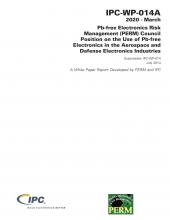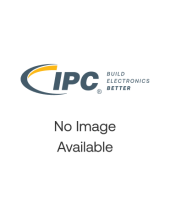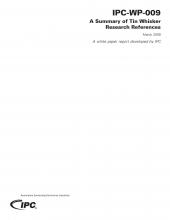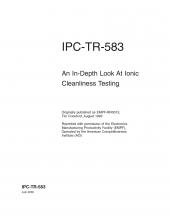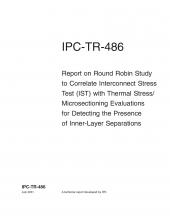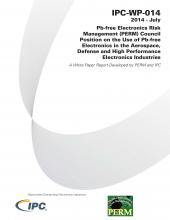Products
Pb-free materials are considered a major technology disruption to traditional Pb-based interconnect materials for electronics, which is of particular concern for the aerospace & defense industries where safety cannot be compromised and applicable reliability data remains scarce. Until validated data and modelling methods are developed, projects considering Pb-free Aerospace & Defense products and...
Lead-free electronics continues to be a concern of the aerospace, defense, and high performance products (ADHP) industries. This is primarily due to the lack of data and knowledge to: thoroughly categorize performance under harsh service conditions and provide a level of confidence in reliability assessments of Pb-free electronics equal to those for traditional tin-lead electronics. To help close...
The PERM Lead-Free Manhattan Project (LFMP) was established to identify the technology and knowledge gaps relevant to the implementation of commercially available Pb-free product in Aerospace & Defense Systems. These knowledge gaps threaten to affect the safety, performance and reliability of Aerospace & Defense systems, which cannot be compromised. Investment is required to close these knowledge...
IPC-WP-023 is an IPC Technology Solutions White Paper addressing reliability issues associated with stacked microvias. There is evidence that staggering vias can result in a more robust structure; however, staggering microvias is only a temporary solution to accommodate complex designs with microvias built with weak interface structures IPC-WP-023 white paper provides an investigation of these...
Manufacturers of high reliability electronics have been working for many years to mitigate the deleterious effects of tin whisker formation. One highly effective means to suppress the growth of tin whiskers is to replace the pure tin plating with reflowed tin-lead solder. One approach is to fully consume the tin plating by tin-lead solder during the SMT reflow process. This phenomenon of tin...
Status of the technology discussion on the various methodologies for mounting and interconnecting active devices to a variety of substrate materials is summarized in this document. Reviews mounting techniques of tape automated bonding (TAB), chip on board (COB) and flip chip. Examinations of the most commonly used substrate options of laminate, ceramic and silicon are also reviewed. Editor: John...
The IPC Solder Products Value Council’s Technical Subcommittee Report “Take Action Limits (TAL) for SAC305 Lead Free Soldering Processes Utilizing Solder Baths/Pots” reports on research on take action limits of solder pot contamination for SAC305 lead-free solder. As opposed to one maximum contamination level, the IPC SPVC opted to identify three action levels: Normal operation defined as the...
As most of the world converts to lead-free manufacturing, the concern over tin whiskers as a reliability hazard has grown due to the emergence of pure tin as a dominate component surface finish. A significant amount of research on tin whisker formation and tin whisker mitigating strategies has been performed in both commercial and defense industries. This working paper is a summary of the...
This document details the test procedures, test results and team conclusions for the IPC Cleaning and Cleanliness Testing Program, Phase 3, Low Solids Flux in Ambient Air. This effort has been part of a multi-stage program to investigate material and process alternatives to the use of chlorofluorocarbons (CFCs) in electronics manufacturing. This Phase 3 effort has been dedicated to characterizing...
This original research was a cooperative effort between the EMPF and IPC, released as EMPF-RR-0013 in 1993 for better understanding of ionic cleanliness testing. The IPC Ionic Conductivity/Ion Chromatography Test Task Group has validated its continued importance and relevance to the cleaning community and IPC-TR-583 is the result. It includes how solvent temperature influences the final...
This technical report provides full detail of the round robin study charged with assessing the use of Interconnect Stress Test (IST) as a test for incoming inspection in lieu of Thermal Stress in the detection of innerlayer separations in plated-through holes. Includes background on the Post Separation Task Group, test results, round robin test plan, conclusions and test methods used. 51 pages...
Details the results of a two-year study to determine the effect of steam aging exposure on components. A variety of solderable finishes were used. A small production simulation utilized preconditioned and as-received samples and tested a total of 2,000 joints. 15 pages. Released July 1996.
This addendum to J-STD-001, originally developed for Revision B but also applicable to Revision C, proposes solutions for cost-effective testing and increased implementation. Also covers other assembly test methods that are not addressed in J-STD-001. 12 pages. Released October 1996. Now available in electronic format.
A Technical Paper by Dr. Jack Brous discussing ionic cleanliness measurement, testing methods and cleanliness standards in relation to product reliability. Also includes a brief discussion of no-clean fluxes. 8 pages. Released 1994
Pb-free materials are considered a major technology disruption to traditional Pb-based interconnect materials for electronics, which is of particular concern for the aerospace, defense, and high performance products (ADHP) industries where safety cannot be compromised and applicable reliability data remains scarce. Until validated data and modelling methods are developed, projects considering Pb...
This technical report provides the documentation of a round robin testing effort that generated data used by the 4-14 Plating Processes Subcommittee in developing the maximum immersion silver plating thickness requirement in the revision A of IPC-4553. This compendium of data resulted from three information sets: a) Test vehicle assembly report by Celestica, b) Thermal cycle test report by...
Coming Soon
IPC-7095E: Design and Assembly Process Implementation for Ball Grid Arrays (BGAs)
IPC-2294: Design Standard for Printed Electronics on Rigid Substrates
IPC-6904: Qualification and Performance Specifications for Printed Electronics on Rigid Substrates
J-STD-005B: Requirements for Soldering Pastes
IPC-4105: Specification for Metal Base Copper Clad laminates for Rigid Printed Boards
J-STD-004D: Requirements for Soldering Fluxes
IPC-4413: Specification for Finished Fabric Woven from Low Dk Glass for Printed Boards

